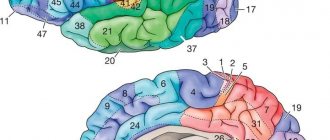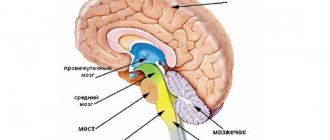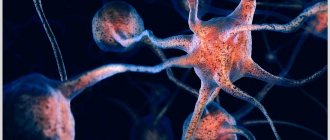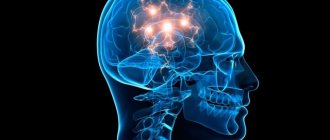From simple to complex
The baby’s nervous system develops in stages, becoming more and more complex every day.
Approximately on the 15th day after conception, the first nerve cells are formed, which will subsequently control the entire body. The development of the brain and spinal cord, as well as the entire nervous system of the child, begins with the formation of the neural tube. This is a strip of nerve cells that grows unevenly. In the head area it forms bubbles, which will then become the brain. In other parts of the body, the stripe bends - these are the future parts of the spinal cord. On the 22nd day after conception, the baby’s brain and spinal cord are not yet protected by anything3. The bones that form the skull and spine will appear later. But since the baby is still in your uterus and floating in the amniotic fluid, he is reliably protected from injuries and shocks. By the end of the first month, three brain vesicles can be seen in the baby’s head area: anterior, middle and posterior. In the sixth and seventh weeks, the anterior and posterior bubbles bifurcate and from three bubbles, five are obtained.
Subsequently, the anterior pair develops into the cerebral hemispheres and diencephalon (thalamus and hypothalamus). The middle cerebral vesicle will turn into the midbrain, to which nature has “entrusted” the performance of a large number of vital functions: it is responsible for vision, hearing, movement control, regulation of sleep and wakefulness cycles, orientation, protective and defensive reflexes, concentration, pain sensitivity, reproductive behavior and body temperature.
The hindbrain vesicle will become the rhomboid brain, the main functions of which are control of breathing and circulation, transmission of information from the spinal cord to the brain, coordination of movements, regulation of balance and muscle tone.
When the nervous system is formed, intrauterine development becomes a very delicate process, which is affected by any negative changes. Therefore, it is so important that you protect yourself from illness and stress, regularly undergo preventive examinations and listen to the advice of doctors. Visiting an obstetrician-gynecologist and following his recommendations is the key to ensuring that your baby develops properly and feels good from the first days of his intrauterine life4.
What is your baby learning?
In the sixth and seventh weeks of pregnancy, in parallel with the brain and spinal cord, the child’s peripheral nervous system is formed: in it the largest cranial nerves can already be distinguished5. They are needed so that the baby’s brain quickly collects and processes information received from all parts of his body. By this time, other large organ systems begin to develop: the heart beats, the liver creates the first blood cells, and the kidneys grow. Also, the child’s arms and legs grow, eyes and ears form, the baby is already becoming like you. Every day he improves more and more, constantly learning new things.
In the second trimester of pregnancy, development continues: the baby already hears your voice and all external noises, and actively explores his body and the environment with his hands. He touches the umbilical cord, sucks his thumb, and develops the reflexes necessary for the future. He coordinates the movements of his limbs and trains daily. You can already feel his rhythmic kicks and thrusts from within. Also in the second trimester, the baby begins to open his eyes, now he may be frightened by bright light and shudder.
The second trimester also begins the process of myelination. This is “protective isolation” for each nerve, it improves its functioning so that your baby quickly learns new things. By the time of birth, the process of myelination is not completely completed; it continues during the first years of the child’s life. In the fifth month of pregnancy, the cerebral hemispheres are still smooth, but when your baby is born, they will already have convolutions and grooves.
Heterochronicity of maturation of neural systems of the brain
The sequence of maturation of the neural systems of the brain in embryogenesis is determined not only by the laws of phylogenesis, but is largely determined by the stage-by-stage formation of functional systems (Fig. V. 1). First of all, those structures mature that should prepare the fetus for birth, that is, for life in new conditions, outside the mother’s body.
Several stages can be distinguished in the maturation of the neural systems of the brain.
First stage. Single neurons of the anterior part of the midbrain and cells of the mesencephalic nucleus of the trigeminal (V) nerve mature most early. The fibers of these cells grow into the
Rice. V. 1. Reconstruction of the nervous system of a human embryo 10 mm long.
direction of the ancient cortex and further - to the neocortex. Thanks to their influence, the neocortex is involved in the implementation of adaptive processes. Mesencephalic neurons are involved in maintaining the relative constancy of the internal environment, primarily the gas composition of the blood, and are involved in the mechanisms of general regulation of metabolic processes. The cells of the mesencephalic nucleus of the trigeminal nerve (V) are also associated with the muscles involved in the act of sucking and are part of the functional system associated with the formation of the sucking reflex.
Second phase. Under the influence of cells maturing at the first stage, the underlying structures of the brain stem of cells maturing at the first stage develop. These are separate groups of neurons of the reticular formation of the medulla oblongata, the posterior part of the pons and neurons of the motor nuclei of the cranial nerves. (V, VII, IX, X, XI, XII), ensuring the coordination of the three most important functional systems: sucking, swallowing and breathing. This entire system of neurons is characterized by an accelerated rate of maturation. They quickly outstrip neurons maturing at the first stage in terms of maturity.
At the second stage, early maturing neurons of the vestibular nuclei, localized at the bottom of the rhomboid fossa, become active. The vestibular system develops at an accelerated pace in humans. Already by 6-7 months of embryonic life, it reaches the degree of development characteristic of an adult.
Third stage. The maturation of neural ensembles of the hypothalamic and thalamic nuclei also occurs heterochronously and is determined by their inclusion in various functional systems. For example, the nuclei of the thalamus, involved in the thermoregulation system, develop rapidly.
In the thalamus, the neurons of the anterior nuclei are the latest to mature, but the rate of their maturation jumps sharply before birth. This is due to their participation in the integration of olfactory impulses and impulses from other modalities that determine survival in new environmental conditions.
Fourth stage. Maturation first of the reticular neurons, then of the remaining cells of the paleocortex, archicortex and basal forebrain. They are involved in the regulation of olfactory reactions, maintaining homeostasis, etc. The ancient and old cortex, which occupies a very small surface area of the human hemisphere, is already fully formed by birth.
Fifth stage. Maturation of neural ensembles of the hippocampus and limbic cortex. This occurs at the end of embryogenesis, and the development of the limbic cortex continues into early childhood. The limbic system is involved in organizing and regulating emotions and motivations. For a child, these are primarily food and drink motivations, etc.
In the same sequence in which the parts of the brain mature, myelination of the corresponding fiber systems occurs. Neurons of early maturing systems and brain structures send their processes to other areas, as a rule, in the oral direction and, as it were, induce the subsequent stage of development.
The development of the neocortex has its own characteristics, but it also follows the principle of heterochrony. Thus, according to the phylogenetic principle, the ancient bark appears earliest in evolution, then the old bark, and only after that the new bark. During embryogenesis in humans, the new cortex is formed before the old and ancient cortex, but the latter develop at a rapid pace and reach maximum area and differentiation by the middle of embryogenesis. Then they begin to shift to the medial and basal surface and are partially reduced. The insular region, which is only partially occupied by the neocortex, quickly begins its development and matures by the end of the prenatal period.
Those areas of the neocortex that are associated with phylogenetically older vegetative functions, for example, the limbic area, mature most quickly. Then the areas that form the so-called projection fields of various sensory systems mature, where sensory signals from the senses come. Thus, the occipital region is formed in the embryo at 6 lunar months, and its full maturation is completed by 7 years of life.
Somewhat later, associative fields mature. The last to mature are the phylogenetically youngest and functionally most complex fields, which are associated with the implementation of specifically human functions of a high order - abstract thinking, articulate speech, gnosis, praxis, etc. These are, for example, speech-motor fields 44 and 45. Cortex The frontal region is formed in a 5-month-old fetus, full maturation is delayed until 12 years of life. Fields 44 and 45 require a longer time to develop, even at high ripening rates. They continue to grow and develop throughout the first years of life, into adolescence and even into adulthood. The number of nerve cells does not increase, but the number of processes and the degree of their branching, the number of spines on dendrites, the number of synapses increase, and myelination of nerve fibers and plexuses occurs. The development of new areas of the cortex is facilitated by educational programs that take into account the characteristics of the functional organization of the child’s brain.
As a result of the uneven growth of areas of the cortex during ontogenesis (both pre- and postnatal), in some areas there is a kind of pushing back of certain sections into the depths of the grooves due to the influx of neighboring, functionally more important ones above them. An example of this is the gradual immersion of the insula into the depths of the Sylvian fissure due to the powerful growth of neighboring sections of the cortex, which develop with the appearance and improvement of the child’s articulate speech - the frontal and temporal operculum - respectively, the speech-motor and speech-auditory centers. The ascending and horizontal anterior branches of the Sylvian fissure are formed from the influx of the triangular gyrus and develop in humans in the very late stages of the prenatal period, but this can also occur postnatally, quite in adulthood.
In other areas, the uneven growth of the cortex is manifested in patterns of the opposite order: a deep furrow seems to unfold, and new sections of the cortex, previously hidden in the depths, come to the surface. This is how, in the later stages of prenatal ontogenesis, the transverse occipital sulcus disappears, and the parieto-occipital gyri, the cortical sections associated with the implementation of more complex, visual-gnostic functions, come to the surface; the projection visual fields are moved to the medial surface of the hemisphere.
A rapid increase in the area of the neocortex leads to the appearance of grooves that separate the hemispheres into convolutions. (There is another explanation for the formation of grooves - this is the germination of blood vessels). The deepest grooves (cracks) are formed first. For example, from 2 months of embryogenesis, the Sylvian fossa appears and the formation of the calcarine groove occurs. Less deep primary and secondary grooves appear later and create a general plan for the structure of the hemisphere. After birth, tertiary grooves appear - small, varying in shape, they individualize the pattern of grooves on the surface of the hemisphere. In general, the order of furrow formation is as follows. By the 5th month of embryogenesis, the central and transverse occipital sulci appear, by the 6th month - the upper and lower frontal, marginal and temporal sulci, by the 7th month - the upper and lower pre- and postcentral, as well as interparietal sulci, by the 8th month. month - middle frontal.
By the time a child is born, different parts of his brain are developed differently. The structures of the spinal cord, the reticular formation and some nuclei of the medulla oblongata (nuclei of the trigeminal, vagus, hypoglossal nerves, vestibular nuclei), midbrain (red nucleus, substantia nigra), individual nuclei of the hypothalamus and limbic system are more differentiated. The neuronal complexes of phylogenetically younger areas of the cortex - the temporal, inferior parietal, frontal, as well as the striopallidal system, the visual thalamus, many nuclei of the hypothalamus and cerebellum - are relatively far from final maturation.
The sequence of maturation of brain structures is determined by the timing of the onset of activity of the functional systems in which these structures are included. Thus, the vestibular and auditory apparatus begin to form relatively early. Already at the stage of 3 weeks, thickenings of the ectoderm are visible in the embryo, which turn into auditory placodes. By the 4th week, an auditory vesicle is formed, consisting of the vestibular and cochlear sections. By the 6th week, the semicircular canals differentiate. At 6.5 weeks, afferent fibers maturing from the vestibular ganglion to the rhomboid fossa. At 7-8 weeks, the cochlea and spiral ganglion develop.
In the auditory system, at birth, a hearing aid is formed that is capable of perceiving irritations.
Along with the olfactory system, the hearing aid plays a leading role already from the first months of life. The central auditory pathways and cortical hearing zones mature later.
By the time of birth, the apparatus that provides the sucking reflex has fully matured. It is formed by the branches of the trigeminal (V pair), facial (VII pair), glossopharyngeal (IX pair) and vagus (X pair) nerves. All fibers are myelinated at birth.
The visual apparatus is partially developed at the time of birth. The central visual pathways are myelinated at birth, while the peripheral ones (the optic nerve) are myelinated after birth. The ability to see the world around us is the result of learning. It is determined by the conditioned reflex interaction of vision and touch. Hands are the first object of one’s own body that comes into the child’s field of vision. It is interesting that the position of the hand, which allows the eye to see it, is formed long before birth, in the embryo at 6-7 weeks (see Fig. VIII. 1).
As a result of myelination of the optic, vestibular and auditory nerves, a 3-month-old child has an accurate alignment of the head and eyes to the source of light and sound. A 6-month-old child begins to manipulate objects under visual control.
The brain structures that ensure the improvement of motor reactions also mature consistently. At the 6-7th week, the red nucleus of the midbrain matures in the embryo, which plays an important role in organizing muscle tone and in the implementation of adjustment reflexes when coordinating posture in accordance with the rotation of the torso, arms, and head. By 6-7 months of prenatal life, the higher subcortical motor nuclei - the striatum - mature. The role of tone regulator in different positions and involuntary movements passes to them.
The movements of the newborn are imprecise and undifferentiated. They are provided by influences coming from the striatum. In the first years of a child’s life, fibers grow from the cortex to the striatum, and the activity of the striatum begins to be regulated by the cortex. Movements become more precise and differentiated.
Thus, the extrapyramidal system comes under the control of the pyramidal system. The process of myelination of the central and peripheral pathways of the functional movement system occurs most intensively up to 2 years. During this period, the child begins to walk.
The age from birth to 2 years is a special period during which the child also acquires a unique ability for articulate speech. The development of a child’s speech occurs only through direct communication with people around him and about the learning process. The apparatus that regulates speech includes complex innervation of various organs of the head, larynx, lips, tongue, myelinated pathways in the central nervous system, as well as the formed specifically human complex of speech fields of the cortex of 3 centers - speech-motor, speech-auditory, speech-visual, united by a system of bundles of associative fibers into a single morphofunctional system of speech. Human speech is a specifically human form of higher nervous activity.
Brain development: useful activities
Scientists believe that listening to classical music, viewing works of art, reading books, and your gentle voice have a positive effect on the formation of a child’s nervous system. Try to develop your baby’s nervous system every free minute. Read as much as possible, including out loud, so that you can be heard, admire the beautiful, enjoy pleasant melodies. Your positive emotions are extremely important for the development of your child’s brain and entire nervous system.
After the 30th week, when maternity leave begins, you can plan a program of cultural events: visiting exhibitions, museums or field trips. However, consult your doctor and find out which activities should be excluded from the list. So, prolonged standing, climbing steep stairs or being in noisy rooms should be avoided.
Stages of the long journey
It all begins even before birth, when three weeks after conception a magical transformation occurs, the formation of an embryo - three petals of different cells, one of which begins to create a nerve canal. Initially primitive, over time this channel will turn into a real miracle - the brain, thanks to whose capabilities we perceive and analyze information, learn and create, make decisions and develop. Surprisingly, it has been proven that already at this stage the developing brain perceives information and depends on external factors. During this period, two points are important for the development of the embryo’s brain: to protect it from the destructive effects of the environment (primarily from alcohol and stress) and to reduce the risk of developing defects of the nerve canal already at the stage of its formation by taking vitamin B9 (folic acid). Brain development occurs constantly, the creation of new synapses begins in the mother’s body and continues throughout life, occurring under the influence of various stimuli and through learning. The effectiveness of a synapse depends on how often it is used: the more often a nerve impulse passes through it, the larger and more effective it becomes. And vice versa! In other words, the development of brain abilities is directly related to its involvement.
From birth to age 10, our brains undergo a period of great learning as the neurons we receive at birth strive to make connections. This time of understanding the surrounding world, the time of “why” is very important for the development of brain abilities: billions of neurons formed at birth form axon branches in search of more and more new contacts for the transmission of nerve signals, and the quality of the brain is higher, the richer these connections are. Parental care, communication, answering questions, patience and love play a decisive role during this period. After the stage of increase in synapses, the stage of their reduction begins, this is how critical periods of development pass, during which learning to walk, speak, read, etc. occurs, and this continues until the end of the teenage stage. Once these periods are over, learning becomes much more difficult and stimulation plays an important role during this time. Practice shows that children from orphanages, deprived of stimulation, suffer from developmental delays, which are difficult to compensate for in the future. How to stimulate the development of a child's brain? The answer is simple, like everything ingenious: you need to talk to the child. Nothing can replace these simple and most important activities: playing with a child, talking to him. A child’s brain, like a computer, records information, but cannot reproduce it until a certain point.
Between the ages of 10 and 18, personality formation occurs, and the brain is determined by the selection of the neurons and connections it needs. At the same time, the process of assimilation of useful information is accelerated, that is, the process of specialization is underway. Brain development at this time is very active: new technologies are mastered, creative abilities are intensively realized, and at the same time, unnecessary neurons and connections are discarded. During this period, teenagers are usually very vulnerable, which, combined with egocentrism, maximalism, laziness and irrationality, makes up a rather explosive mixture. During this period, they need support and understanding, patience and love. It’s also not easy for parents during this period, but they should not doubt: they mean a lot to the teenager, it’s just that now he doesn’t need to be directed, but to be there, trust and accompany him. Alcoholic drinks and drugs, which (especially during this period) constitute a risk factor for brain development and health, can cause significant harm. When exposed to alcohol, a tomograph shows damage to the white matter and worsening results are noted when analyzing cognitive tests. Drugs, in addition to addiction, pose a risk of developing schizophrenia and developing depression.
From 20 to 60 years of age, the brain is still making synapses, but the brain needs constant feeding to create new connections. By about 25 years of age, the process of brain development a8 is completed, by this time the main chains of connections are built and stabilized and the prefrontal lobe, in which higher cognitive actions are stored, finally matures. After 30 years, the brain works “at full capacity”, easily ensuring the uninterrupted operation of all body functions. We take this for granted and think about health only when we experience difficulty remembering, headaches, dizziness, difficulty finding a word... But we need to constantly take care of brain health: this is necessary to increase brain performance, maintain its efficiency and prevent destruction. After the peak of efficiency, the process of extinction gradually begins. But the brain has the resources to produce new neurons, which means neural plasticity and the ability to recover. In addition, the brain can change and create new synapses until death, and this plasticity allows you to adapt to changing life situations and conditions. When learning something new, ions are exchanged between neighboring neurons and new synapses are created, but the establishment of new connections requires feeding: oxygen, nutrients, energy. The brain needs to be trained, supported and fed, sometimes even stimulated. Increased brain performance can also be achieved with the help of medications. We'll talk about this in more detail a little later. The important thing is that the number of neurons cannot be increased in this way, you can only achieve temporary stimulation of brain activity, but the price of the issue can sometimes be high.
After 60 years, the brain is not as active, but does not lose cognitive ability. And if a person continues to be curious and active, his chances of avoiding neurodegenerative processes increase. Games for brain development, books, classes in interest clubs, learning something new that you never had enough time for before will come to the rescue. Brain aging is associated with oxidation of neuronal membranes and “hardening” of axons, which slows down the transmission of nerve impulses in the circuit. You can avoid this process or significantly slow down its course with online brain training and proper nutrition, which is also important. You should also avoid stress, not allowing it to damage nerve cells. Activity, positive thinking, pleasant communication with people, and, if necessary, the use of a hearing aid (after all, due to hearing impairment, people are often forced to withdraw into themselves) will help to adequately spend this period of life that awaits each of us.









